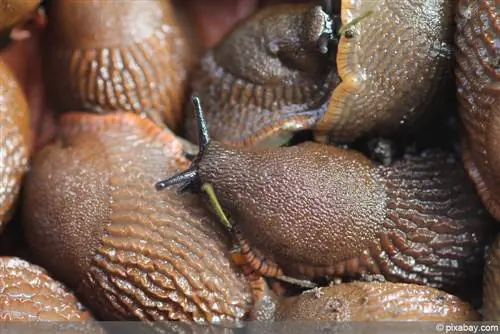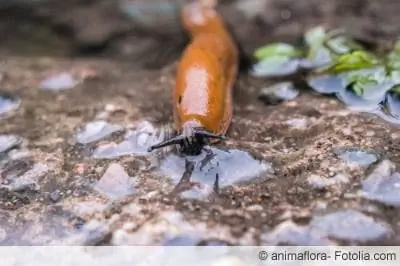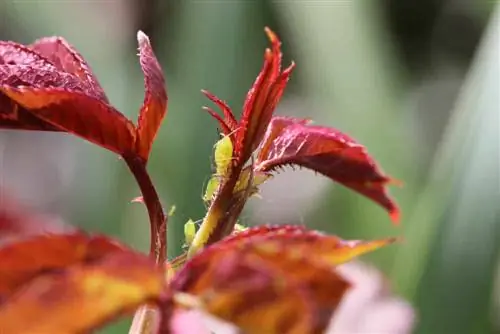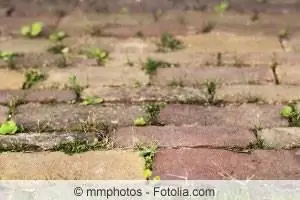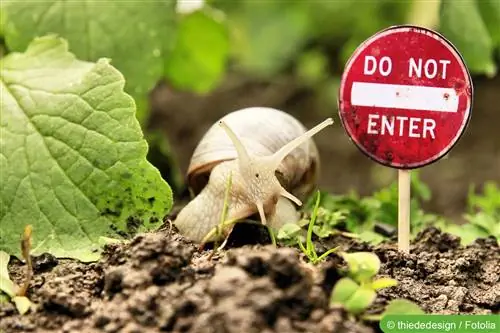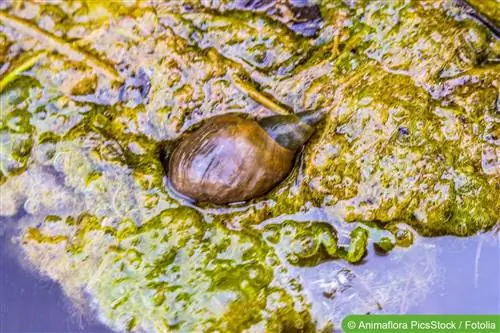- Author admin [email protected].
- Public 2023-12-17 03:39.
- Last modified 2025-01-24 12:45.
Snails can drive gardeners crazy. But those who feel drawn to nature prefer to use biological methods to combat snails instead of chemistry. An effective method is to ward off snails with moss or moss extract. But not all types of moss are suitable. Find out everything you need to know about mosses, how you can make the extract yourself and fight snails in the long term.
Moss effect
Mosses rarely serve as food for animals and at the same time not as a breeding ground for fungi. This is due to the fact that they produce an active ingredient in their cell walls. This includes, among other things, the substance oxylipine, which is usually formed when a moss is injured.
If the snails eat a plant that is covered with a moss plant, they injure it and the substances that protect the animals are produced and released. As a result, they spoil their appetite and stop nibbling. So much for the theory, because this principle only works to a limited extent, as some snails are less deterred by this because the substances are not secreted in large quantities and therefore some specimens are not deterred by it. However, products containing moss extracts are significantly more effective.
Moss extract effect
While mosses only deter snails to a limited extent because they only produce a few defensive substances per centimeter when injured, moss extracts have the advantage of applying the defensive substances directly to a plant. This results in a significantly higher effectiveness than with pure mosses.
The University of Bonn has examined the effectiveness of mosses or moss extracts in various studies. Lettuce leaves were drizzled with the extract and presented to different species of snails to eat. In all test series, only the untreated lettuce leaves were eaten and the greatest possible distance was kept around the leaves prepared with moss extracts.
Suitability for large areas
Now it would be easy to “enclose” the garden with extract and in this way achieve an effective snail defense for the entire garden. However, that is not the case, because even scientific research has not yet developed a recipe for synthesizing that would allow the extract to be produced in larger quantities, because up to now huge amounts of mosses have been necessary in order to be able to produce the smallest amounts of the extract. This would make the product economically unviable on the market and unsuitable for large areas. Nevertheless, hobby gardeners have the option of making their own, although not every type of moss is effective in successfully combating snails.
Food suitability
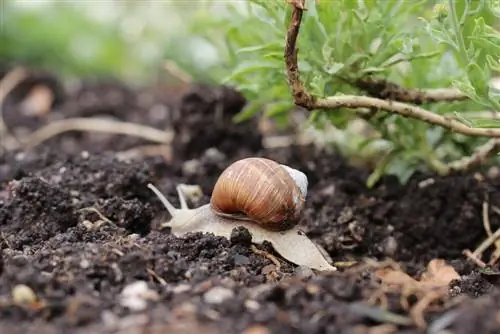
Particularly when it comes to foods such as vegetables and fruit, the potential he alth-endangering factor plays a major role. Mosses only have a defensive function for animals such as snails. This form of snail control is non-toxic to people and pets and is therefore harmless to he alth when used in normal doses. You should only wash fruits and vegetables treated with extract carefully before using or consuming them. But this has more of a hygienic reason than a he alth reason.
Liverwort
Liverwort is best suited as a snail repellent, as has been proven in some experiments with slugs by renowned scientists at the University of Bonn. There are countless species of liverwort, most of which have leaves and can therefore be distinguished from many other types of moss. They grow in warm, humid areas and are widespread in Central Europe. With a little luck, liverwort will also grow in your garden. If not, it can often be found in forests, where it sticks up tree trunks towards the sunny side.
peat moss
Peat moss would theoretically also be suitable, but it should be noted that this type of moss is a protected plant in Germany and cannot be collected or used to combat snails. If an environmentalist or the forester discovers you, this can result in high pen alties. So it says here:NO SEAT MOSS!
Lawn moss
As an alternative to liverwort, lawn moss is a good option. Not everyone wants to go to the trouble of searching forests for liverwort and inquire about the identification in advance. Repellent against snails is easier with lawn moss, as it is easy to see in the lawn.
Lawn moss is not as effective as liverwort, but is still worth trying. It is usually available after scarifying the lawn and does not have to be laboriously pulled out of the ground.
Moss
There are different experiences as to whether leaf moss is useful for controlling snails. In some cases it works, in others less so. Some experts are of the opinion that leaf moss does not contain enough of the necessary active ingredients, like liver moss and lawn moss. If you have the opportunity to obtain liver moss or, alternatively, lawn moss, you should choose it over leaf moss before all your efforts turn out to be in vain.
Buy
If you don't want to go to the trouble, you can buy moss extract from various manufacturers both online and in a well-stocked local gardening store. Jean Pütz, for example, offers it as a plant strengthener. As a rule, it is not marketed directly to ward off snails, but, as already mentioned, as a plant strengthening agent that can be used against pest, fungal and bacterial infestations and for their treatment. Depending on the product, either a few milliliters of the moss extract are added to a liter of water or it can be used directly as a ready-made solution in a spray bottle.
Self-making
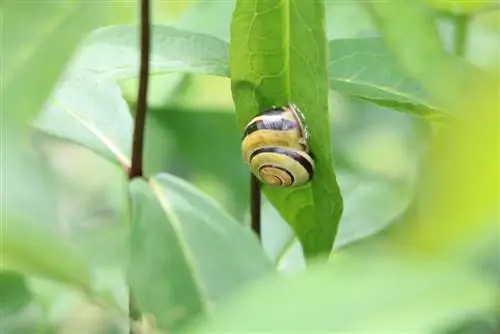
Various options are available for production. But they all have three things/processes in common: always use fresh moss and chop it up. The meaning of the latter is that the “injury” causes the natural defenses to be formed, which you can use to ultimately fight the snails. Unfortunately, the more you chop up the mosses, the less you produce more of the substances. Here it is the amount of moss that determines the amount of material. In addition, there is the respective concentration when you mix the components obtained into an extract. After shredding, it is best to let the fresh and shredded moss plant dry well in the fresh air.
- Cold water production
- Use cold water
- Pour water into a bucket and add dry moss
- Water-dry moss ratio: 1:10
- Stir well
- Let it steep for at least a day
- Sifting out the contents of the bucket
- Pour the brew into a spray bottle
- Spray susceptible plants every second or third day as a preventive measure with the resulting extract/decoction
- Extract lasts for a maximum of ten days
Tip:
You should never spray the extract in direct sunlight as this can cause burns to the leaves. It is better to apply early in the morning, in the evening or in a shady place.
- Alcohol
- Mix 50 grams of dry moss with 100 milliliters of 30 percent alcohol
- Let it steep for an hour or two
- Then fill the mixture with water to 20 liters
- Filter or sieve out the moss mixture
- Pour the brew into a spray bottle
- Spray directly onto the plant and spray everything
- Initially use about twice a week
- After that, one application once a month is sufficient
- Extract can be stored for a few weeks
Hot water production
- Fill the cylindrical container one quarter with dry moss and three quarters with water
- Water should be at least room temperature, preferably between 23 degrees Celsius and 27 degrees Celsius
- Do not stir the mixture
- Let it steep for a day
- Then stir briefly and let it steep for another 30 minutes
- Sift out or filter out any moss residue
- Pour extract/decoction into a spray container
- Spray plants dripping wet
- Use every other day for the first week
- Use once a week from the second week onwards
- If it rains a lot, spray twice a week
Advantages and disadvantages
In addition to combating numerous species of snails, the moss extract also has the positive effect of strengthening plants and acting against various diseases and pests. It is suitable as a preventative measure as well as direct treatment in acute cases.
These include, for example:
- Downy and powdery mildew on roses
- Gray mold rot
- Bulb and late blight on root vegetables
- Fruit and leaf rot
- Spider mites
- Aphids
One negative point that should be mentioned, however, is that the mosses extract does not work for all snails. Some specimens remain unaffected and do not let this stop them from eating. But it is a remedy that reliably helps mainly with the particularly voracious slugs and does not leave any environmentally harmful residues in the soil. With the recipes mentioned here for making yourself, the chances of successfully keeping the pests away from your plants are very good.

